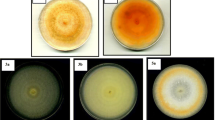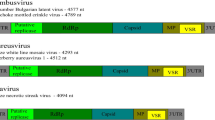Abstract
A putative mycovirus belonging to the proposed family “Fusariviridae” was discovered in Setosphaeria turcica by sequencing a double-stranded RNA extracted from this phytopathogenic fungus. The virus was tentatively named “Setosphaeria turcica fusarivirus 1” (StFV1). StFV1 has a genome comprising 6685 nucleotides. The genome contains three open reading frames (ORF). The largest ORF, ORF1, is preceded by an untranslated region (UTR) of 16 nucleotides and separated from ORF2 by an intergenic region of 63 nucleotides. The smallest ORF, ORF3, overlaps ORF2 by 16 nucleotides and is followed by a 3'-UTR of 82 nucleotides. The protein encoded by ORF1 is 71.8%, 67.4% and 68.1% identical to the RNA-dependent RNA polymerases (RdRps) of Pleospora typhicola fusarivirus 1 (PtFV1), Plasmopara viticola lesion-associated fusarivirus 1 (PvlaFV1), and Plasmopara viticola lesion-associated fusarivirus 3 (PvlaFV3), respectively, but has less than 47% amino acid sequence identity to the RdRps of other fusariviruses. To our knowledge, this is the first fusarivirus discovered in S. turcica and the first virus to be identified in this fungus using conventional cloning methods.


Similar content being viewed by others
References
Ghabrial SA, Castón JR, Jiang D, Nibert ML, Suzuki N (2015) 50-plus years of fungal viruses. Virology 479:356–368
Kanhayuwa L, Kotta-Loizou I, Ozkan S, Gunning AP, Coutts RHA (2015) A novel mycovirus from Aspergillus fumigatus contains four unique dsRNAs as its genome and is infectious as dsRNA. Proc Natl Acad Sci USA 112:9100–9105
Sato Y, Shamsi W, Jamal A, Bhatti MF, Kondo H, Suzuki N (2020) Hadaka virus 1: a capsidless eleven-segmented positive-sense single-stranded RNA virus from a phytopathogenic fungus, Fusarium oxysporum. mBio 11(3):e00450-e520
Kwon SJ, Lim WS, Park SH, Park MR, Kim KH (2007) Molecular characterization of a dsRNA mycovirus, Fusarium graminearum virus-DK21, which is phylogenetically related to hypoviruses but has a genome organization and gene expression strategy resembling those of plant potex-like viruses. Mol Cells 23:304–315
Zhang R, Liu S, Chiba S, Kondo H, Kanematsu S, Suzuki N (2014) A novel single stranded RNA virus isolated from a phytopathogenic filamentous fungus, Rosellinia necatrix, with similarity to hypo-like viruses. Front Microbiol 5:360
Zhong J, Shang HH, Zhu CX, Zhu JZ, Zhu HJ, Hu Y, Gao BD (2016) Characterization of a novel single-stranded RNA virus, closely related to fusariviruses, infecting the plant pathogenic fungus Alternaria brassicicola. Virus Res 217:1–7
Zhong J, Zhao SQ, Li GF, Pang XD, Deng XJ, Zhu HJ, Gao BD, Zhou Q (2016) A novel fusarivirus isolated from the phytopathogenic fungus Nigrospora oryzae. Virus Genes 52(6):891–895
Hao F, Ding T, Wu M, Zhang J, Yang L, Chen W, Li G (2018) Two novel hypovirulence-associated mycoviruses in the phytopathogenic fungus Botrytis cinerea: molecular characterization and suppression of infection cushion formation. Viruses 10(5):254
Marais A, Nivault A, Faure C, Comont G, Theil S, Candresse T, Corio-Costet MF (2018) Molecular characterization of a novel fusarivirus infecting the plant-pathogenic fungus Neofusicoccum luteum. Arch Virol 163(2):559–562
Botella L, Hantula J (2018) Description, distribution, and relevance of viruses of the forest pathogen Gremmeniella abietina. Viruses 10(11):654
Liu W, Hai D, Mu F, Yu X, Zhao Y, He B, Xie J, Jiang D, Liu H (2020) Molecular characterization of a novel fusarivirus infecting the plant-pathogenic fungus Botryosphaeria dothidea. Arch Virol 165(4):1033–1037
Li X, Sui K, Xie J, Hai D, Yin W, Sossah FL, Jiang D, Song B, Li Y (2020) Molecular characterization of a novel fusarivirus infecting the edible fungus Auricularia heimuer. Arch Virol 165(11):2689–2693
Zhang L, Chen X, Bhattacharjee P, Shi Y, Guo L, Wang S (2020) Molecular Characterization of a novel strain of fusarium graminearum virus 1 infecting Fusarium graminearum. Viruses 12(3):357
Marzano SL, Nelson BD, Ajayi-Oyetunde O, Bradley CA, Hughes TJ, Hartman GL, Eastburn DM, Domier LL (2016) Identification of diverse mycoviruses through metatranscriptomics characterization of the viromes of five major fungal plant pathogens. J Virol 90(15):6846–6863
Zhu JZ, Zhu HJ, Gao BD, Zhou Q, Zhong J (2018) Diverse novel mycoviruses from the virome of a hypovirulent Sclerotium rolfsii strain. Front Plant Sci 9:1738
Picarelli MASC, Forgia M, Rivas EB, Nerva L, Colariccio A (2019) Extreme diversity of mycoviruses present in isolates of Rhizoctonia solani AG2-2 LP from Zoysia japonica from Brazil. Fronti Cell Infect Microbiol 9:244
Xie J, Jiang D (2014) New Insights into mycoviruses and exploration for the biological control of crop fungal diseases. Annu Rev Phytopathol 52:45–68
Ghabrial SA, Suzuki N (2009) Viruses of plant pathogenic fungi. Annu Rev Phytopathol 47:353–384
Cao Z, Zhang K, Guo X, Turgeon G, Dong J (2020) A genome resource of Setosphaeria turcica, causal agent of northern leaf blight of maize. Phytopathology. https://doi.org/10.1094/PHYTO-06-20-0225-A
Gilbert KB, Holcomb EE, Allscheid RL, Carrington JC (2019) Hiding in plain sight: New virus genomes discovered via a systematic analysis of fungal public transcriptomes. PLoS ONE 14(7):e0219207
Deng Q, Wang H, Li C, Li P, Fang S, Yang S, Yan F, Zhang S, Chen Z (2017) The complete genomic sequence of a novel alphapartitivirus from Bipolaris maydis, the causal agent of corn southern leaf blight. Arch Virol 162(8):2433–2436
Lu S, Wang J, Chitsaz F, Derbyshire MK, Geer RC, Gonzales NR, Gwadz M, Hurwitz DI, Marchler GH, Song JS, Thanki N, Yamashita RA, Yang MZ, Zhang D, Zheng C, Lanczychi CJ, Marchler-Bauer A (2020) CDD/SPARCLE: the conserved domain database in 2020. Nucleic Acids Res 48(D1):265–268
Kumar S, Stecher G, Tamura K (2016) MEGA7: molecular evolutionary genetics analysis version 7.0 for bigger datasets. Mol Biol Evol 33(7):1870–1874
Nguyen LT, Schmidt HA, von Haeseler A, Minh BQ (2015) IQ-TREE: a fast and effective stochastic algorithm for estimating maximum-likelihood phylogenies. Mol Biol Evol 32(1):268–274
Nerva L, Ciuffo M, Vallino M, Margaria P, Varese GC, Gnavi G, Turina M (2016) Multiple approaches for the detection and characterization of viral and plasmid symbionts from a collection of marine fungi. Virus Res 219:22–38
Chiapello M, Rodríguez-Romero J, Ayllón MA, Turina M (2020) Analysis of the virome associated to grapevine downy mildew lesions reveals new mycovirus lineages. Virus Evol. https://doi.org/10.1093/ve/veaa058
Acknowledgements
This work was supported by the National Natural Science Foundation of China (no. 31972243), the Science and Technology Project of Guizhou Tobacco Company (no. 201921f), and the Opening Fund of Key Lab of Biopesticide and Chemical Biology, Ministry of Education, Fujian Agriculture and Forestry University. We are grateful to Dr. Fangluan Gao and Dr. Zhenguo Du at the Institute of Plant Virology, Fujian Agriculture and Forestry University, for their help in preparing the manuscript.
Author information
Authors and Affiliations
Corresponding authors
Ethics declarations
Conflict of interest
All authors declare that they have no conflict of interest.
Ethical approval
This article does not contain any studies with human participants or animals performed by any of the authors.
Additional information
Handling Editor: Ioly Kotta-Loizou.
Publisher's Note
Springer Nature remains neutral with regard to jurisdictional claims in published maps and institutional affiliations.
Rights and permissions
About this article
Cite this article
Gao, Z., Cai, L., Liu, M. et al. A novel previously undescribed fusarivirus from the phytopathogenic fungus Setosphaeria turcica. Arch Virol 166, 665–669 (2021). https://doi.org/10.1007/s00705-021-04954-x
Received:
Accepted:
Published:
Issue Date:
DOI: https://doi.org/10.1007/s00705-021-04954-x




